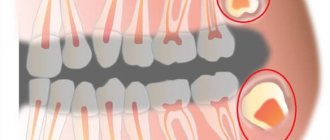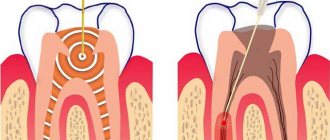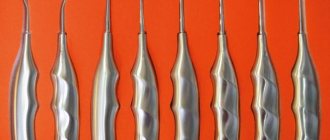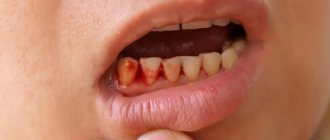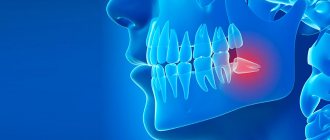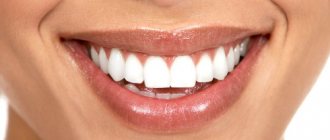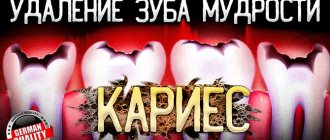Teething rarely occurs without complications. When the figure eight appears on the gum surface, inflammatory processes develop. The pathology in medicine is called pericoronitis, or wisdom tooth hood. The disease is treated in two ways: medication and surgery. Untimely therapeutic measures can lead to the development of an abscess or flux in the oral cavity, which can lead to further blood infection and death. It is necessary to consider the main symptoms of pericoronitis, the causes of its occurrence and methods of elimination at home and in the dental clinic.
What is pericoronitis
Dentists refer to wisdom teeth as eights or last (third) molars. They can grow at any age, and their absence in the oral cavity is considered normal. The main feature of the elements during growth is the formation of a hood over the crown. The hood is represented by soft gum tissue that hangs over the problem unit.
Food particles and bacteria gradually become lodged under the gums, causing inflammation and bad breath. The condition also leads to difficulty chewing food and the proliferation of pathogenic flora in the mouth. The hood interferes with the normal eruption of the last molar.
Difficult eruption manifests itself in a clear clinical picture: the patient develops severe swelling of the face and body temperature rises. Such signs are a reason to immediately contact a dentist, and then a surgeon for urgent assistance.
Inflammation from the hood gradually spreads to the bone tissue of the tooth and jaw. The hood delays the timely cleansing of the oral cavity from bacteria and food debris. The main symptoms of the pathological condition: pain when chewing and swallowing food, swelling of the gums and cheeks, disruption of the full functioning of the dentofacial apparatus.
Causes of inflammation
The first eight begins to erupt in a person from 18 to 25 years of age, less often at a later age. The main reasons for the problematic appearance of the last element on the gum surface is the lack of space in the dentition due to the reduction in the size of the jaw of a modern person. Another reason for the appearance of pericoronitis is the retraction of the unit.
Retraction is the incomplete emergence of a tooth to the surface.
If the growth is abnormal, the third molar compresses the sevens and causes their premature destruction. In some cases, wisdom teeth rest against the soft tissues of the cheek, which also leads to inflammatory processes in the mouth and sore gums.
A wisdom tooth hood can occur due to uneven growth of the figure eight. Inflammation usually develops under the retreated part of the crown. The unpleasant symptoms will go away on their own after the remaining part of the tooth appears on the surface of the gum. Trouble-free growth of a unit is possible only if there are no obstacles in its path.
When a wisdom tooth is removed along with the hood
There are several reasons why only partial removal is ineffective. Among them, the first place in a kind of popularity ranking goes to insufficient free space.
In practice, this means that a massive tooth simply has nowhere to grow without cutting through the still healthy surrounding surfaces of varying degrees of hardness. If it has a problematic growth slope towards a neighboring tooth or even bone, then it is subject to emergency excision. After this, healing will not take long to occur.
In second place is the absence of other teeth adjacent to the third molar. Then preserving the problematic “tenant” does not have any practical benefit, because such a long distance is not suitable for reliable prosthetics.
Adding to the complexity is the fact that the formation of a hood is the prerogative of exclusively those wisdom teeth that have not yet been able to fully stick out. Because of this, a complex operation may take longer, and the recovery period may be longer than usual.
The reason for the delay is that there is simply no special scheme for accessing the problematic tooth from its socket using standard dental instruments. Here everything depends on the individual characteristics of each victim, which prompts the doctor to use a drill to divide the tooth into several parts. Only after this will it be possible to remove the cut parts from the alveolar process.
For such a long-term intervention, the dentist may use general anesthesia if he sees that his patient is on the verge of having a panic attack. The dentist will come to the same logical conclusion when he is faced with the irresistible gag reflex of his patient. This is explained by the fact that even the most careful master sometimes touches the patient’s tongue, which in some people provokes a strong vomiting reaction. To avoid traumatic situations, it is more productive to simply put a person into a stage of artificial sleep.
Contraindications for general anesthesia are only pregnancy in the first and last trimester.
The price of the service will depend entirely on what type of anesthesia was used, and whether anything else had to be removed other than the actual hood.
Symptoms
The hood of a wisdom tooth makes itself felt only a few days after formation due to the fact that food debris accumulates under it. Bacteria multiply more actively in a favorable environment, which ultimately leads to the appearance of symptoms of pericoronitis. Saliva does not penetrate under the hood, and this interferes with the normalization of the microflora under the gum.
What to do if your wisdom tooth is cutting out and your gums hurt
The development of dental disorders is indicated by:
- swelling of the gums;
- pain when swallowing saliva;
- putrid odor from the mouth;
- temperature increase;
- dizziness;
- swelling of the face.
What to do if one or more symptoms of pericoronitis appear? The listed signs are a reason for a visit to the dental clinic. Lack of timely treatment threatens the development of infectious complications. The pathological process often spreads to the masticatory muscles. In this condition, even minor movements of the jaw will be accompanied by pain.
The infection spreads through numerous vessels in the oral cavity to neighboring systems and organs. Because of this, with pericoronitis, an exacerbation of chronic pathologies is observed. In such a situation, drug treatment will not bring the desired results: surgical intervention will be necessary.
Wisdom tooth: inflammation of the hood and its symptoms
Patients who have inflamed gums near a wisdom tooth usually complain to the doctor that their wisdom tooth is growing, their gums are swollen, and there is also an odor from the wisdom tooth. The formation of an unpleasant odor is caused by the formation of pus, which is gradually released from under the hood. Patients also complain of pain in the area of the wisdom tooth. Such symptoms correspond to only a mild form of pericoronitis.
What do the symptoms of pericoronitis look like in the video? Please note that in the video below you can see the following symptoms: redness and swelling of the hood above the upper wisdom tooth, a small amount of purulent discharge (white) from under the hood. Such symptoms correspond to a mild form of inflammation.
If pericoronitis occurs, treatment is only possible with a dental surgeon. But at the initial stage, patients try to relieve the symptoms on their own using available means: antiseptic rinses, dental drops, painkillers. In most cases, this is ineffective and the inflammation only increases. The following symptoms increase (in various combinations):
increasing pain- severe swelling and redness of the gums,
- swelling of the cheek (Fig. 4),
- purulent discharge from under the hood,
- painful swallowing
- difficulty opening the mouth,
- increase in body temperature,
- weakness,
- swelling and tenderness of the submandibular lymph nodes.
Important: if at this stage the wisdom tooth hood has not yet been removed (see below), then you should be prepared for the next development of events. Firstly, because inflammation occurs in the area of the masticatory muscles - their spasm can lead to almost complete closure of the mouth. If at this moment you decide to go to the dentist, then he will not be able to do anything for you if your mouth is not opening enough, except to refer you to the hospital.
Secondly, pus may begin to spread not into the oral cavity, but rather deep into the bone and soft tissues, which will cause the formation of an abscess or phlegmon (peripharyngeal or submandibular). The latter complications will also mean inevitable treatment in a hospital, and therefore it is better not to bring the inflammation of the wisdom tooth to a critical level.
Drug treatment
If, with swelling of the gums and cheeks, the patient cannot see a doctor immediately, then he should resort to emergency measures. It will not be possible to completely stop the inflammatory process at home, so a visit to the doctor will be mandatory.
Before visiting the dentist, you need to rinse your mouth with furatsilin solution every 2-3 hours. For this purpose, other pharmacological agents with an antiseptic effect can be used - Chlorhexidine, Miramistin, Rotocan. And you can also use traditional medicine to rinse your mouth, for example, tea leaves or tincture of crushed garlic.
The list of other alternative medicine used to prevent complications of pericoronitis includes:
- baths based on sea salt and soda: 1 tsp. each dry ingredient is dissolved in 200 ml of warm water;
- treating the wisdom tooth hood with saline solution.
To relieve the symptoms of itching and discomfort, gels with an anesthetic effect are used: Lidocaine, Kamistad, Cholisal.
You should not open or cut off the inflamed area of the gum on your own. A similar procedure must be performed by a surgeon taking into account all antiseptic rules. Only in this case will it be possible to avoid more dangerous infectious consequences.
Surgery
The essence of the intervention is to excise the hood over the wisdom tooth and fill the wound with antiseptic agents that will prevent the infection from spreading into the deeper layers of the gum. The surgeon will not prescribe surgery if there are pronounced purulent processes in the gums, since there is a high risk of infection of nearby tissues.
In case of purulent inflammation, the surgeon makes an incision in the gums in order to quickly rid the patient of necrotic masses. After the intervention, the patient will be prescribed antibiotics and anti-inflammatory drugs. In rare cases, the surgeon immediately suggests wisdom tooth removal.
Removing part of the gum involves excision of inflamed tissue. Thanks to this, the infectious focus is removed, which causes the active proliferation of bacterial flora in the mouth. The operation is characterized by low trauma, except in cases where it is necessary to remove a large volume of affected tissue.
The operation is performed by a doctor under local anesthesia. For anesthesia, Lidocaine or Ultracaine is usually used; Novocaine is used only in rare cases, for example, when an incision in the gum is necessary, rather than removal of the inflamed area. Minor discomfort may appear 30–40 minutes after surgery, so you should immediately take a pain reliever when you get home.
The average cost for a service in paid clinics is from 2,500 rubles, depending on the complexity of the operation, the volume of surgical work and the need for sutures. In provincial cities, the cost of the procedure can be several times lower. At the clinic at your place of residence, the procedure will be performed free of charge upon presentation of your passport and insurance policy.
Stages of the procedure for the treatment of pericoronitis of the third molar:
- Performing an injection with an anesthetic.
- Excision of the overhanging part of the gum 15 minutes after the injection. The surgeon performs the procedure using a scalpel, less often using a laser.
- Treatment of the wound resulting from excision.
- Placement of iodoform turunda on the site where the soft tissue was excised.
After the intervention, the surgeon gives a referral to the patient for a re-examination. And the specialist also advises the patient regarding behavior during the recovery period.
Advanced dental clinics recommend laser excision of the problem area of the gum to patients. This method of intervention will prevent excessive bleeding and minimize the risk of complications. Unfortunately, only a rare dental clinic in Russia can boast of innovative equipment.
Excision of the hood over the wisdom tooth - reviews
Olga
https://www.woman.ru/health/woman-health/thread/4253149/8/
My hood was cut off today. Nothing hurt at all, it was just uncomfortable with this hood. They gave me painkillers, quickly cut off all the excess, I didn’t even feel it. I was more afraid and shaking. Almost three hours passed, the anesthesia had almost worn off. Well, there is no severe pain yet, I just can’t open my mouth wide, it hurts. The doctor said to rinse with water and baking soda. That's all. That's what I'm doing for now. Seems to be OK. Let's see what happens next.
Guest
https://www.woman.ru/health/woman-health/thread/4253149/8/
Yesterday they cut off the hood above the left eight. I endured it for 4 days before, then I went to give up. They charged 4500 in a paid clinic. They prescribed Avelox, Bifiform, Nise and rinse with chlorhexedine. After taking Avelox, she fainted and started vomiting. The ambulance gave me an allergy shot. The antibiotic didn't work. Plus I'm allergic to penicillin. I replaced it with ciprolet, which seems to be normal. There is no particular pain.
Julia Vollkova
https://xlebez.ru/issechenie-kapjushona-nad-zubom-mudrosti/
+ Advantages: fast, effective
— Disadvantages: relapses are possible, takes a long time to heal
Hello! Today I will write about an unpleasant procedure that I had to endure twice. I got my first wisdom tooth when I was a teenager. My jaw is narrow and the standard set of teeth is too much for it) As a result, the tooth made itself felt through a rather painful and time-drawn-out eruption and growth. Everything would be fine, but at some point the gum above the tooth began to constantly become inflamed. Rinsing did not help for long; food debris got stuck under the hood and was impossible to get out. And at the next peak of inflammation, accompanied by fever, I went to see a dental surgeon at a regular clinic. Then I was only 14 years old and I did not consider other options.
Naturally, people with fever and pain are accepted without a queue and without a coupon. In the office I was shaking, I don’t know what more, either from the temperature, or from fear. The doctor injected me with freezing and sent me to rest for about 10 minutes. As soon as I stopped feeling my cheek, as well as my nose and generally a good half of my face, I was invited into the office again. Surprisingly, everything went very quickly, a couple of clicks with surgical scissors and I was free. They prescribed Nurofen or paracetamol, for some reason I thought it was because of the temperature, and rinsed with furatsilin. They also advised not to drink for a couple of hours, and for the first time to eat, if possible, only in the evening (considering that I did the procedure early in the morning). I must say that the procedure is quite bloody. When I put away the cotton wool with the medicine half an hour later, I still felt the taste of blood in my mouth. When I arrived home, the frost began to subside, and I realized that not everything was over yet, the torment was just beginning. Nurofen made me feel a little better, but I couldn’t rinse my mouth at all - it hurt! It all went away in four days.
And a few years later, this same hood, over the same tooth, appeared again. I realized this when I started to feel bad breath. Food again got under the hood (I assume that the first time the procedure was done anyhow. Remembering how I suffered for several days after the dissection, I began to look for an alternative. And they offered it to me - cut with a laser, fortunately nowadays this procedure is done in many dental clinics. Everything is the same - first they freeze it, then they cut it. And with a laser it turns out very carefully, there is less blood. Just the fact that you don’t hear the clank of scissors is worth a lot)) The only thing is that even with freezing, I felt like it was baking quite strongly. Perhaps the freezing did not fully work. But, I was extremely surprised when the anesthesia wore off that I practically didn’t feel any pain! The next day I forgot about this procedure, ate everything and enjoyed life. But just in case, I regularly rinsed my mouth with the prescribed alcohol solution of chlorophyllipt for several days.
YANGUL
https://galya.ru/clubs/show.php?id=994050
I had it removed at a state dental clinic for free. They did a bad job on one tooth and had to repeat the procedure, but on the second it went without any problems. It healed in about 2 days and then there was no more pain at all.
volodyaVLAD
https://otzovik.com/review_6613112.html
Advantages:
The inflammation has disappeared.
Flaws:
Long recovery period.
3 wisdom teeth came out a long time ago, but recently the 4th one began to appear - at the bottom. The gums around him became inflamed and began to hurt, not to say very badly, but the gums ached disgustingly for three days. Having read about what this could mean, I went to see a doctor at the nearest paid dentistry. I expected that they would offer me to pull out a tooth, having taken a picture before doing so. I was ready for this. But when I saw the doctor, she diagnosed “pericoronitis” (food debris got under the hood over a tooth that had not yet grown, and it became inflamed) and suggested cutting off the inflamed gum. I wasn’t ready for this, but they scared me that tomorrow I might not open my mouth. In general, under the persuasion of the doctor, I decided to do it. First they sprayed my gums, it became less sensitive, then they gradually gave me 3 injections of anesthetic. The entire right side of my face was numb. The doctor tested the strength of the anesthesia by cutting a little with a scalpel. Do not feel. And she started working. The operation lasted approximately 20 minutes, there was no sensation. Then they put cotton wool in my mouth, I had to press it with my teeth. I couldn’t talk after the operation. When the frost started to go away, it was unpleasant, but not to say it hurt. I was prescribed to rinse my mouth with a salt solution several times a day, this was supposed to promote rapid healing. But one unpleasant thing happened - the mouth did not open, the little finger could not even fit into it. 2 weeks passed, the mouth began to open a little more, but bread, cookies, fruits - large foods, the spoon did not fit. I went back to the doctor - she suggested removing the wisdom tooth, as if it was the cause. I read on the Internet that this was due to improper anesthesia, I decided to wait a little longer, and began to slowly open my mouth by force, stuffing more and more food into it. As a result, only after a month my jaw began to work as before, and I was able to eat normally. They didn’t cut my hood, but cut it off completely, but it still grew back after 2 months, food began to clog, it became inflamed again, I started rinsing with a salt solution - it passed for a while. And then the wisdom tooth just came out completely and the hood stopped bothering me. If the wisdom tooth did not come out, then either the hood would have to be removed again, or the wisdom tooth would have to be removed.
Aryata
https://irecommend.ru/content/issechenie-kapyushona-zuba-mudrosti-pri-beremennosti-gnoi-v-desne-nad-zuboim-mudrosti-vospal
Wisdom teeth are a strange thing! They decide when to appear, bringing a lot of problems and troubles to their “lucky” owner.
My lower left “eight” appeared about a year and a half ago. It was already visible and rose above the gum almost level with the other neighboring teeth. I had already forgotten about it, but during pregnancy this tooth decided to remind me of itself.
It was New Year's weekend... The whole country was on vacation, and I was climbing the wall in pain. At first I decided that stomatitis had started, so I made a decoction of chamomile and oak bark and rinsed my mouth with them. The pain became more and more intense. The gum around the wisdom tooth is swollen and covers 2/3 of the tooth. Dentists were not working at that time, so I decided to wait until the end of the weekend and suffer...
When I could no longer sleep at night because of the pain, I went to the emergency dental care center. There I was delighted with the diagnosis of “pericoronitis” - inflammation of the hood of a wisdom tooth. There was no talk of any stomatitis. The doctor suggested cutting this very hood, freeing the tooth.
No sooner said than done! First, they injected anesthesia, which can be given to pregnant women, and then, using something similar to scissors with a disgusting sound, they cut off everything that was in the way, and also cleaned the gums of pus (but, as it turned out later, not completely). It’s not painful, but it’s disgusting, and a lot of blood flows during this procedure...
After three hours, the freezing passed and I had to experience all the delights of what is popularly called “otkhodnyak”. The doctor forbade taking painkillers and antibiotics, prescribing only baths and rinses.
I somehow survived the night; baths with salt and soda made me sick, so I simply made them from herbal decoctions and iodine.
In the morning I saw that the incision site had festered, the entire wound was filled with pus... Apparently, without antibiotics, the body did not want to cope with the inflammation.
I had to act on my own! I started rinsing my mouth with chlorhexidine and a ready-made solution for rinsing "Angiosept", plus I did not cancel herbal decoctions.
The pain went away the very next day, or rather became quite tolerable. The pus began to stand out more and more; the infection completely disappeared on the fifth day after the gum incision. Perhaps the process would have gone faster with antibiotics.
The pain went away completely on the third day, but the pus bothered me. Yes, in five days there was no trace of him left, but I was quite nervous.
Conclusions:
- If it weren’t for the pain that made me want to shoot myself and the sleepless nights with hungry days (I couldn’t open my mouth, I couldn’t eat normally, and I didn’t want to at all), I wouldn’t have decided on the procedure to remove the hood of a wisdom tooth. And I was also worried about the child.
- The operation is quite unpleasant, and the pain after the anesthesia wears off is also difficult to endure without painkillers.
- The gums, of course, heal quickly, but the first day or two are quite difficult to survive.
- Sometimes it is worth going through this unpleasant procedure; most often there is no alternative.
- The main thing is that complications do not arise. The rest is all quite survivable.
hey_ksenia
https://irecommend.ru/content/odin-doktor-no-ochen-raznye-oshchushcheniya-vtorichnyi-opyt-obernulsya-pytkoi
Good day!
This is the second time I have encountered the problem of difficult eruption of wisdom teeth (eights). But these two times are radically different from each other, even though they were with the same doctor! I want to talk about two separate cases:
1. About a year ago, a figure eight began to appear on the left side. The gums were slightly swollen, painful and red, and it was decided to go to the doctor. As soon as he arrived, showed me and told me about the situation, the dentist injected me with an anesthetic and sent me out the door to wait for the freezing effect. It was a little scary, but I didn’t even know what they would do with him, since I didn’t know about this procedure at all. I thought they would just remove my tooth.
The time has come, the doctor spent about 7 minutes fiddling with the tooth and sent me home, prescribing the antibiotic Lincomycin and rinsing. I really thought that I had a tooth removed (as always, I didn’t ask anything, and it was difficult to open my mouth. Although it didn’t bother me much - the doctor knows best).
I came home and nothing hurt, I just ached a little bit (no doubt) when the frost lifted. But on this day I already ate and was happy with life, in general. Imagine my surprise when two weeks later I saw a tooth in this place. A feeling of joy - and that’s all!
And just yesterday history repeated itself, but on the other side of the gum...
2. I went to the clinic in the morning.. I stood in line since 6:30 in the morning.. and then at 8:20 I ended up in the office of the same doctor. I showed the place with the tooth, the doctor asked me whether we would remove the tooth or cut off the gum (last time he was not so talkative). Having learned that my tooth was fine and could be saved, I, of course, decided that we would leave it and just remove the gum above it, like last time - is that really a problem? But as soon as they started injecting me with painkillers, it became very painful for me, well, that’s how it’s supposed to be - we can endure it!
About 10 minutes later they called me and started doing all the manipulations with the tooth. I heard and felt everything (intuitively, without pain), just unpleasant: the grinding of scissors on a tooth, the constant closing of scissors, cutting off gums, warm blood and spitting.. Brr.. I opened my eyes only while spitting. All this took about 15-20 minutes - although it seemed like an eternity! They put a gauze bandage on me, but not the same as last time - which I can remove in 40 minutes, but with medicine, which I can remove only tomorrow, when I come to their clinic. Prescribed medications: antibiotic Lincomycin, Metrogil-dent ointment and rinsing with chlorhexidine after removing the gauze; in case of bleeding, Dicynone was prescribed.
But the worst thing began upon arriving home...
The freezing had not yet completely lifted, but I already felt a sharp pain, which was difficult to endure. If before I could fall asleep after the dentist, in this case it didn’t work. I took a pill
Pentalgin, which slightly relieved the pain (but not completely). Waking up an hour later, I realized that the pain not only did not go away, but had also doubled. I wanted to jump and howl in pain. It was decided to have a drink
Nimesil. He helped me very well and I fell asleep for five hours, waking up at 7 pm. Now there is only slight discomfort (how can I say it) and pain when swallowing.
It is now eleven o'clock, the gums are still bleeding and saliva is released every five minutes (most likely due to the gauze with the medicine). This causes a lot of inconvenience.
Also, as I already said, it hurts me to swallow - due to the fact that the area with the gum immediately pulls.
It is difficult and painful to eat. All I ate today was porridge in the morning (before visiting the doctor) and 1 liter of kefir after. I definitely won’t chew solid food due to discomfort.
I hope that there will be no complications and everything will heal quickly, I will be glad to write about the final positive result!
All two procedures cost me free.
It can be painful, or it can be completely painless. Despite the fact that I have had this procedure twice in my life and had both a positive and a negative character, I believe that it is necessary, since the consequences of non-intervention can be much worse.
One thing I can say for sure - you will not forget this!
ADDENDUM 10/26/2016.
The next day at 9:00 am, as expected, they took off the medicine and put sterile gauze on me. Bleeding began, as if a tooth was extracted.
An hour later I went to the doctor (another doctor took the medicine, since it was Saturday), he told me that the bleeding would stop, I could remove the gauze, and drink Dicinon for better clotting, which I did..
What happened next... Don't read for the impressionable. The blood did not stop flowing and coagulated, and a huge lump of blood began to form behind the cheek, covering the entire cheek, making it difficult to unclench the teeth to drink the antibiotic... Although the time was already more than 13:00 in the afternoon. It was scary.
Another doctor said that on this day it would be necessary to rinse with chlorhexedine.. I tried.. Lumps of blood began to slowly separate, I thought that they were bleeding.. But after two hours or less I realized that the lump had returned to its original place and became just as big. This meant that the blood had definitely not stopped... I spat it out every 60 seconds, and sometimes I had to swallow...
It was scary, it was Saturday... And even the private clinics where I wanted to go were no longer open... I hoped to wait until the morning.. But an acquaintance persuaded me to go to the state one. clinic (not in the dental office itself) for emergency cases.. It was 10:00 pm..
Upon arrival, they called a dentist for me (the same one who originally cut the hood came, in my city there is one state dental clinic with two surgical doctors, and they call from there).
We went up to the 4th floor and, after examination and testing, they removed the blood with gauze, injected me with an anesthetic and stitched me up...
This happened right on the operating table, and not in the dental office chair..
Describe the sensations? Perhaps it’s hardly worth it...
At the end, they injected me with something (they said that, but I had no time to remember and understand) into the muscle, gave me ammonia and sent me home, accompanied by friends who were waiting below.. It was 00:00 at night..
I arrived home and tried to sleep, because I felt the impending pain.. At 3:00 I woke up, it’s not clear why..
Then the days began, one similar to the other.. I wake up every day either at 4:30 or around 6:00.. There are night pains and groans that are noticed by loved ones.. And also, food is not food that I just swallow, because... that when chewing, the teeth fall on this gum. Severe weakness appeared and it was decided to take vitamins..
Today, 10.26.16 - three days after the stitches were put in, they were removed and the medicine was put back on me. Take off the medicine after 2 days...
To say that I’m scared, sometimes in pain and tired of everything is to say nothing... They constantly tell me: “Why did you cut at all?!”.. That, they say, everything went away by itself before... I have to explain several times what was already there inflammation and pain...
I myself think maybe I should have waited?!..
Today is 11/10/16 - after the medicine was taken off two days after the stitches were removed, everything slowly began to heal.. There was no more blood.. STILL Sometimes I bite my cheek and don’t chew on the right side, I don’t know how long this will last..
So, it's time to summarize... I have had both normal and very negative experiences with hood excision. This review is to warn about possible events, and maybe even warn... It's up to you to decide.. Whether this is the work of a “master”, or a matter of chance..
I went through all this and perhaps it’s impossible without these manipulations...
Features of the recovery period
After removal of pericoronitis, the surgeon prescribes to the patient:
- rinsing the mouth with Chlorhexidine solution (up to 4 times a day);
- taking antibacterial agents (not in every case);
- use of painkillers (up to 5 days).
How long will your gums hurt after the intervention? Full recovery of the patient occurs 4–5 days after the procedure. Rehabilitation after traumatic types of surgery takes up to 7 days. If a week after surgery there is severe pain in the operated area or swelling of the soft tissues, you should contact a surgeon to evaluate the previous treatment.
Special gels sold in pharmacies will help you cope with inflammation faster: Cholisal, Kamistad. They accelerate the healing of damaged mucous membranes.
The turundum with iodine solution is removed from the socket 24 hours after the operation. It is advisable that the procedure be carried out by a surgeon, but removing the napkin at home is also acceptable; the iodoform turundum remaining in the socket will later become a source for the spread of infection.
Before removing the napkin, you must wash your hands with soap. After the home procedure, the wound is treated with 3% hydrogen peroxide. Repeated formation is a reason for another operation, during which the doctor will decide on the advisability of leaving the wisdom tooth in the oral cavity. Recurrent pericoronitis is an indication for eliminating the problem unit. There are other indications for wisdom tooth extraction.
What to do after the procedure
The healing process will largely depend on how the patient takes care of the oral cavity and teeth in the days following the removal of the hood.
- During the first hours after the procedure, it is not recommended to eat or drink.
- Within 24 hours after removal, solid foods should be excluded from the diet. Until the wound heals completely, you need to chew food on the other side of the mouth.
- You need to take care of your oral cavity very carefully, use rinsing, and be extremely careful when brushing your teeth so as not to injure the site of the hood excision.
- In addition to medications prescribed by the doctor, cold is indicated on the side where the hood was.
- To prevent the development of the inflammatory process, overheating (hot food, bath) should be avoided.
Indications for unit removal
The most effective method of treating gum inflammation above the third molar is to remove the latter. Before the procedure, the doctor will order an x-ray for the patient. The operation will be complicated if the figure eight has curved roots.
The list of situations in which the best way to solve the problem is to remove wisdom teeth includes:
- Insufficient length of the lower jaw. In this case, there will not be enough space to cut through the figure eight. In this case, extraction surgery is prescribed to prevent the remaining teeth from moving into an anatomically incorrect position. Timely intervention will prevent possible malocclusions.
- Inclination towards the third molar. The tilt can be observed towards the other elements or towards the cheek. An unremoved element will injure the mucous membranes of the cheeks or destroy the roots of a neighboring tooth.
Diagnostics
Any dentist can perform the diagnosis. To do this, you should study the symptoms and take an x-ray. Using the image, the doctor will see how the tooth is located, the condition of the bone tissue that surrounds it, as well as the condition of the periodontium. If the disease is chronic, then bone resorption is studied. Pericoronitis is treated by dentists in our dental center.
Features of wisdom tooth removal surgery
The operation to extract the problematic unit takes much longer than removing the hood of a wisdom tooth. The procedure is especially difficult for patients with a pathological fear of dental treatment. In difficult cases (improper location of roots, incomplete tooth eruption), tooth extraction in stationary conditions is indicated.
Complex operations and panic fear before the procedure may serve as an indication for performing the operation under general anesthesia. The procedure can also be prescribed to people with an increased gag reflex. This type of surgery does not last long and is painless for the patient.
Let's consider situations in which surgery to remove wisdom teeth is prohibited:
- Exacerbation of chronic diseases. In this case, it is necessary to wait for remission of the pathology in order to avoid complications after surgery.
- Pregnancy.
Preparing for surgery
You should not be afraid of dental hood removal surgery. It is performed under local anesthesia and does not cause serious discomfort to the patient. But for therapy to be successful, it is important to carefully prepare for it.
First, the doctor talks with the patient and listens to his complaints, finds out how long ago the inflammation occurred and how much it bothers him. Then he examines the oral cavity and palpates the inflamed area. Writes out a referral for radiography. Based on the diagnostic results, he decides whether the wisdom tooth can be saved.
A mandatory stage of preparation for surgery is taking blood tests for coagulation and some other indicators. If the inflammation is severe, the client may be prescribed antibiotics before surgery to stabilize the situation and create optimal conditions for excision of the overhanging hood.
If the doctor deems it necessary, he will first perform professional oral hygiene. During this procedure, he will remove accumulations of hard and soft dental plaque. This is necessary in order to reduce the likelihood of postoperative inflammation.
Possible consequences
Complications can arise even after simple excision of the gum located above the wisdom tooth. A common consequence is repeated inflammation. The problem arises due to non-compliance with antiseptic rules or insufficient removal of the gums above the wisdom tooth. Less commonly, consequences develop due to the anatomical features of the structure of the wisdom tooth.
If you refuse to visit a doctor, pericoronitis may become more complicated:
- development of a chronic inflammatory process in the oral cavity;
- injury to the mucous membranes of the cheek;
- thinning of the bone tissue of the jaw;
- development of osteomyelitis;
- inflammation of the submandibular lymph nodes;
- entry of pathogenic flora into the bloodstream;
- the formation of an abscess or phlegmon.
It is difficult to cope with inflammation of the wisdom tooth hood at home. The problem is caused by the growth of wisdom teeth and eruption. On their own, a person can only prevent the rapid development of infectious consequences. To do this, he needs to thoroughly brush his teeth and use special rinses after hygiene procedures. To better treat hard-to-reach areas of the oral cavity, threads or irrigators are used. In this case, a visit to the dentist will be necessary.
Rehabilitation period
How long it will take for your gums to recover depends on many factors:
- volume of tissue removed;
- client age;
- individual characteristics of the patient’s body;
- correctness of the operation;
- accuracy of patient compliance with medical prescriptions.
To make rehabilitation as simple and fast as possible, you need to remember the rules:
- Do not eat for three hours after completion of surgical treatment.
- Remove the turunda (compress) only when the doctor tells you to. However, it should not be in the mouth for more than a day.
- Do not chew food on the same side of the jaw on which surgery was performed.
- Do not eat hot or very cold foods. The same goes for drinks.
- During hygiene procedures, do not touch the wound with a brush.
- Strictly take all medications prescribed by the dental surgeon.
- Do not self-medicate (it is unacceptable to try to speed up recovery using dubious folk methods).
If the patient listens to the advice of his doctor, the wound will heal quite quickly.
